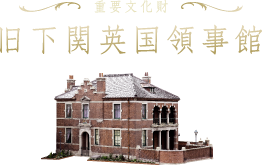
The British Consulate in Shimonoseki was opened at 26 Akama-cho on September 1901 following a report by Sir Ernest Mason Satow, the then British Minister to Japan. It was the first consulate established in Shimonoseki.
Originally, a small Japanese-style building formerly used as a store was converted for use as the temporary British Consulate. A new consulate was built at the present location in December 1906. The consulate was used by successive consuls until 1922 and later by acting consuls who took charge of consular affairs instead. The consulate was closed towards the end of 1940 due to the worsening relationship between Japan and Britain.
After the former consulate became a possession of Shimonoseki City in 1954, it was used for various purposes including as a police station and as an archaeological museum. Because the former consulate was designated as a Tangible Cultural Property by the City of Shimonoseki on June 3, 1987, it was reconstructed and has since been used as an exhibited cultural property and gallery for citizens. In December 2008, the former consulate was closed for work for preservation and restoration. Earlier, on May 13, 1999, the former consulate was designated an Important Cultural Property by the National Government.
The work for preservation and restoration was started to enable the conservation and use of the former consulate for the next 100 years. Soil improvement, structural reinforcement and other necessary work was undertaken over about five and a half years. Another purpose of the work was to turn the former consulate into a base for the provision of information on cultural properties and sightseeing in the Karato District. It was reopened as a public facility in July 2014.

The Former British Consulate in Shimonoseki is the oldest existing building in Japan that was constructed for use as a consulate. Its character as a consulate is evident in the arrangement of the main building and the outbuilding. It is precious as a typical diplomatic facility built in the Meiji Era (1868-1912). It consists of the main building, the outbuilding and a brick wall that surrounds them and marks the boundary of the precincts. The Heigushi (A kushi staff) stating that the consulate was completed on August 9, 1906 remains as important historical evidence of the date of construction.
How the Consulate Was Originally Used


The main building is a two-storey brick building. The first floor was used as an office for the consul etc. , and the second floor as the residence of the shipping clerk. The contrast between the red bricks and white stones contributes to the beautiful appearance of the building. It is characterized by a stepped gable with a chimney resembling a staircase and a three-part arch.
Among the indoor features, the mantelpiece decorating the fireplace and the tiles give a pleasant impression.

The L-shaped outbuilding to the north of the main building is comprised of a kitchen, a servant’s room, a coal storage room and a toilet. Part of the servant’s room was floored with tatami. It is a one-storey brick building. The design of the outbuilding is modeled after the main building, but it is simpler.

Reproduction and exhibition of the former Consular Office

Provision of information on the history of exchanges between Shimonoseki and Britain, and the history, culture and tourist spots, etc., of surrounding areas

Floor Resting room (cafe & pub)

Meeting room



During the work for repair and conservation from 2008, the emblem on the upper part of the entrance, which had been lost, was restored with the permission of the British royal family.
For this work, efforts were made to restore the emblem truthfully based on old photographs and advice from Britain’s College of Arms, etc.


(9.00 a.m. – 10.00 p.m. for resting room, courtyard and gallery in outbuilding)
*Please direct inquiries on days when the Former British Consulate is closed to the contact office shown below or refer to the Consulate’s website.
〒750-0005 4-11 Karato-cho, Shimonoseki
TEL. +81-(0)83-235-1906
FAX. +81-(0)83-235-1901

































